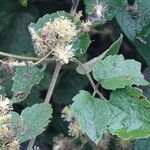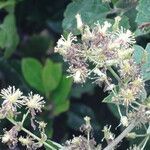Leaves imparipinnate with 5 leaflets, but frequently reduced in association with the inflorescence; leaflets ovate to ovate lanceolate, acuminate or shortly acuminate, rounded to cordate at the base, entire to regularly dentate but nearly always entire towards the base, usually not lobed but leaflets of the upper leaves occasionally with 1–2 lobes, nearly glabrous to densely pubescent on lower surface, a few scattered hairs on upper surface.
A tall woody climber. It can be 20 m long. Young stems are hairy. The leaves have 5 leaflets with one at the end. The leaves are broadly sword shaped and round at the base and tapering to the tip. Leaflets on the upper leaves can have lobes. The flowers are cream or white.
Tall woody climber up to 20 m. or more, often behaving as a strong liane; younger stems more or less hairy but usually becoming glabrous or nearly so, longitudinally ribbed and furrowed.
Inflorescence many-flowered; pedicels 1–3–5 cm. long; flower-buds ellipsoid.
Sepals 7–18 mm. long, cream or white.
A forest climber; up to 120 ft. high.


